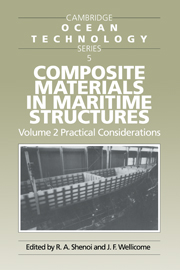Book contents
- Frontmatter
- Contents
- Preface
- List of Authors
- 1 Introduction
- 2 Design of Displacement Craft
- 3 Design of Dynamically Supported Craft
- 4 The Role of Adhesives
- 5 Practical Design of Joints and Attachments
- 6 Production of Ships with Single Skin Structures
- 7 Production of Yacht Hulls of Sandwich Configuration
- 8 Material Case Study - Failures and their Repairs
- 9 Response of Sandwich Structures to Slamming and Impact Loads
- 10 Fatigue Characteristics
- 11 Composites in Offshore Structures
- 12 Regulatory Aspects in Design
- 13 Quality and Safety Assessment
- 14 Design Management and Organisation
- Appendix
- Index
9 - Response of Sandwich Structures to Slamming and Impact Loads
Published online by Cambridge University Press: 04 August 2010
- Frontmatter
- Contents
- Preface
- List of Authors
- 1 Introduction
- 2 Design of Displacement Craft
- 3 Design of Dynamically Supported Craft
- 4 The Role of Adhesives
- 5 Practical Design of Joints and Attachments
- 6 Production of Ships with Single Skin Structures
- 7 Production of Yacht Hulls of Sandwich Configuration
- 8 Material Case Study - Failures and their Repairs
- 9 Response of Sandwich Structures to Slamming and Impact Loads
- 10 Fatigue Characteristics
- 11 Composites in Offshore Structures
- 12 Regulatory Aspects in Design
- 13 Quality and Safety Assessment
- 14 Design Management and Organisation
- Appendix
- Index
Summary
INTRODUCTION
While FRP sandwich has been used in racing and pleasure craft for some considerable time, it is only since the early and mid 1980s that this material has established itself as a major construction material for hulls, decks and superstructures of larger vessels such as high speed passenger ferries. Norwegian and Swedish ship builders have been in the forefront of this development, and it is significant that Norway is currently building nine new mine countermeasures vessels in GRP sandwich (including the shock-exposed areas of the hulls).
In spite of the high degree of confidence attained in the use of FRP sandwich, there have been a number of failures, due to various causes, and it is important to be clear about the problems that can arise if the structure is not correctly designed and built.
In a sandwich panel the skin laminates and the core are of different materials and these have to be fixed together by some form of adhesive bonding. This presents a series of challenges, with respect to both workmanship and materials selection. It has also become extremely important to understand properly the loadings and mechanisms involved, particularly in relation to slamming and to impact with solid objects.
In the autumn of 1988 extremely severe weather was experienced around parts of the Norwegian coast. Several vessels experienced damage – not only ones built in GRP, but there was a relatively high incidence of GRP sandwich failures.
The picture seen typically was a large area of delamination – or, more correctly, separation of the outer skin from the core, with extensive destruction of the PVC foam core, figure 9.1.
- Type
- Chapter
- Information
- Composite Materials in Maritime Structures , pp. 161 - 177Publisher: Cambridge University PressPrint publication year: 1993
- 4
- Cited by

